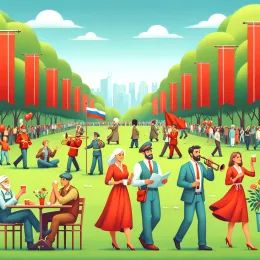What to Say When You Don’t Know What to Say: Greetings for Awkward Situations

Understanding the Challenge of Awkward Greetings
In social interactions, knowing how to start a conversation can be surprisingly difficult, especially when the situation feels tense or uncomfortable. Many people experience moments where they are unsure of what to say, leading to awkward silences or fumbling attempts at small talk. Mastering the art of greeting others in these tricky moments is an essential social skill that can ease tension and foster connection.
When we find ourselves at a loss for words, it is useful to have a toolkit of phrases and strategies that can help break the ice smoothly. This article explores effective greetings and approaches designed specifically for awkward situations, providing you with practical ways to navigate those moments with confidence and grace.
Why Awkward Situations Arise

Awkwardness in conversations often stems from uncertainty or discomfort. These feelings can be triggered by a variety of factors such as meeting someone new, encountering unexpected silence, or engaging with people in emotionally charged settings. Understanding the root causes of awkwardness helps in choosing the right language to move past it.
Common causes include fear of judgment, lack of common ground, or simply the absence of a natural segue in dialogue. Recognizing these triggers prepares you to respond thoughtfully rather than react impulsively, making your greetings more effective and less strained.
The Psychology Behind Awkward Greetings
Human communication relies heavily on nonverbal cues and shared context. When these are missing or unclear, conversations can stall. The brain seeks to fill silences, often causing stress or anxiety, which can manifest as awkwardness. Greetings, as the opening act in social exchanges, carry the weight of setting the tone for what follows.
By consciously selecting words that are neutral, inviting, and easy to respond to, you can reduce the pressure on both parties. This approach fosters a sense of ease and openness, encouraging smoother interactions even when initial comfort is lacking.
Effective Greetings for Different Awkward Scenarios
Not all awkward situations are the same. Tailoring your greetings to fit the context increases their effectiveness. Below are several common scenarios with suggested phrases to help you navigate each one gracefully.
Meeting Someone New in a Quiet Setting
When you encounter a new person in a calm or silent environment, breaking the ice can feel daunting. Simple, open-ended greetings that invite the other person to share are best.
- “Hi, I don’t think we’ve met before. I’m [Your Name]. How’s your day going?”
- “Hello, this is a nice spot. Do you come here often?”
- “Hey there, I’m curious—what brought you here today?”
These phrases encourage conversation without putting pressure on the other person, making the interaction feel natural.
Reconnecting with Someone After a Long Silence
When reconnecting, the awkwardness often arises from the gap in communication or uncertainty about the current relationship status. Honest and light-hearted greetings can bridge this gap.
- “Wow, it’s been a while! How have you been keeping?”
- “Long time no see! What’s new in your world?”
- “Hey! I was just thinking about you the other day. How’s everything going?”
These expressions acknowledge the distance without dwelling on it, opening the door for a pleasant exchange.
Dealing with Awkwardness in Group Settings
Group dynamics can heighten awkwardness, especially when you don’t know everyone well. Using inclusive greetings that address the group while allowing individuals to respond comfortably works well.
- “Hi everyone, nice to see you all here. How’s the week treating you?”
- “Hello! I’m glad we could all get together. Anyone have any fun plans coming up?”
- “Good to be here with you all. What’s the latest buzz around?”
These greetings help create a shared atmosphere and reduce the pressure on any single person to carry the conversation.
Techniques to Make Greetings Feel More Natural
Beyond specific phrases, the way you deliver greetings plays a crucial role in overcoming awkwardness. Your tone, body language, and timing can greatly influence how your words are received.
Using Body Language to Complement Your Words
Nonverbal cues often speak louder than words. A warm smile, open posture, and steady eye contact can convey friendliness and approachability, making even simple greetings feel genuine.
These signals reduce perceived social distance and invite engagement, helping to ease the atmosphere before you say a word.
The Power of Humor and Self-Deprecation
Injecting light humor or acknowledging the awkwardness with a touch of self-deprecation can break tension and build rapport quickly.
For example, saying something like “Well, I’m usually better at this, but I guess we’re breaking new ground here” creates shared laughter and diffuses discomfort.
Timing and Pausing
Sometimes the pressure to fill silence leads to more awkwardness. Allowing a brief pause before greeting can demonstrate confidence and thoughtfulness. It signals that you are comfortable with the moment, encouraging the other person to relax as well.
Table of Sample Greetings for Awkward Situations
| Scenario | Sample Greetings |
|---|---|
| Meeting Someone New |
|
| Reconnecting After Time Apart |
|
| Group Gatherings |
|
| Unexpected Silence |
|
Building Confidence to Handle Any Social Situation
Confidence is key when addressing awkward moments. The more you practice these greetings and techniques, the more natural they will feel. Over time, you will internalize a set of responses that suit your personality and communication style.
Remember that everyone experiences awkward moments, and showing genuine interest and kindness is often more important than having the perfect opening line. Approaching social situations with empathy and openness creates connections that transcend initial discomfort.
Practice and Reflection
Reflecting on your own social interactions and experimenting with different greetings can enhance your skills. Consider journaling about encounters where you felt awkward to identify what worked and what didn’t. This mindfulness helps in honing your approach.
Seeking Feedback and Learning from Others
Observing how friends or colleagues navigate awkward greetings can provide valuable insights. Don’t hesitate to ask trusted individuals for feedback on your conversational style. Learning from others’ experiences enriches your own communication abilities.
Embracing the Imperfection of Human Interaction
Finally, it is important to accept that not every greeting will go perfectly. Social interactions are dynamic and influenced by many factors beyond your control. Embracing imperfection allows you to be more forgiving of yourself and others when moments feel awkward.
By focusing on genuine connection rather than flawless execution, you create space for meaningful relationships to grow, even when the words don’t come easily at first.






































